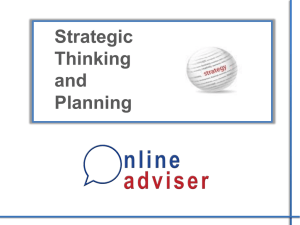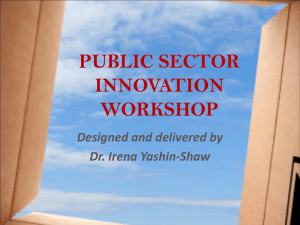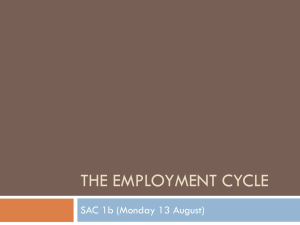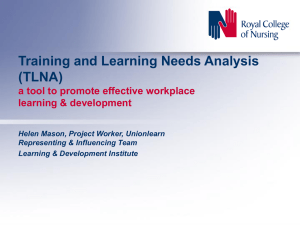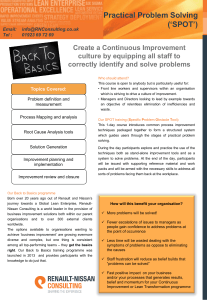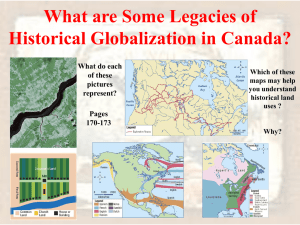Management-Innovation-PowerPoint
advertisement
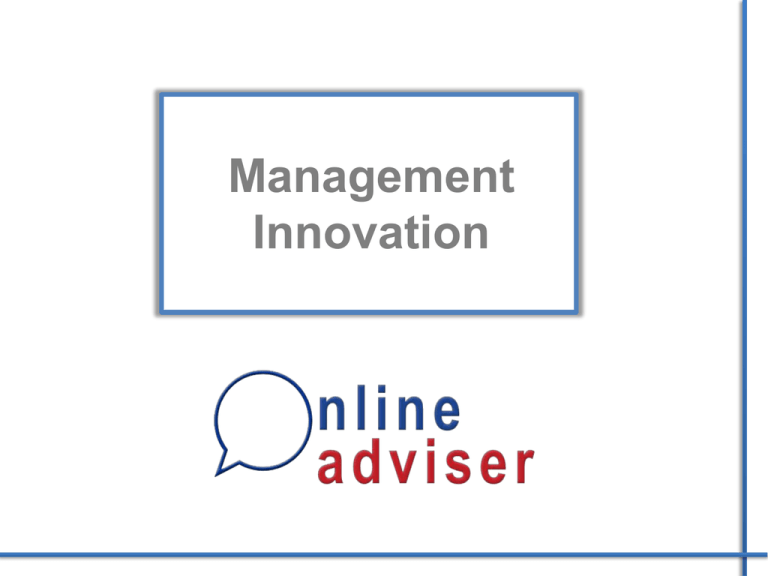
Management Innovation Introduction This presentation aims to assist you to: •Understand “management” theory and how it has developed over time •Understand why management innovation is important in today’s business climate •Understand what it entails •Identify ways to innovate your current management model A history of ‘management’ Management has been around since the dawn of civilization Management-like thought can be traced back to the builders of the pyramids of ancient Egypt, where the first “managers” had to supervise and motivate the slaves, tell them what to do, follow up and ensure the task was done, and then to chastise those whose performance was not satisfactory A history of ‘management’ However, it was only at the end of the 19th century , and the industrial revolution, that management as a concept was developed “The hit them with a whip” school of management was predominant during this period, where workers were seen as machines expected to produce results – the goal being mass production and maximum output, and to increase the wealth of owners A history of ‘management’ Other methods of managing workers received classical expression in Frederick Taylor’s Scientific Management Theory in 1911 “Taylorism” led to the development of new management tools involving such techniques as measurement and statistics Organisations were characterised by: •Command and control, hierarchy of authority •Impersonal rules, standardised procedures •Promotion based on achievement •Employees not to be trusted •Human rights ignored •Environmental concerns ignored •Competitive advantage gained by an organisation’s ability to produce goods efficiently – the “production era” A history of ‘management’ During the 1960’s management theory took a more human approach Post World War 11 thinking meant that there was a greater respect for democracy and the recognition of a more educated workforce Abraham Maslow, a psychologist developed a Hierarchy of needs for human beings (1954), which was reflected in the changes in thinking around management and management theory Individual thought, needs, a sense of belonging self-actualisation became recognised as important for workers to be able to be fully productive Maslow’s Hierarchy of Needs [adapted for the workplace] Growth Creativity Self actualisation Self esteem, status, prestige accomplishment Social, belonging Intimate relationships, friends Safety, security Physiological Food, water, warmth, rest A history of ‘management’ 1940’s to 1970’s saw growth and expansion of markets Markets were growing and the “multinational firm” was established Profits grew by increasing market size – “the market economy” Competitive advantage gained by market size and service excellence Challenging legacies of past Many management models used today are still based on the legacies of the past, and the remnants of these old methods still exist Gary Hamel, the well known guru on management innovation and Professor of the London Business School, states that most of the essential tools and techniques of modern management were invented by those individuals born in the 19th century, and that a radical overhaul of this ageing technology is required [Daniel H. Pink. Drive: The Surprising Truth About What Motivates Us (Kindle Location 2313). Riverhead Books] Challenging legacies of past Traditional management models – with emphasis on hierarchy and the importance of labour inputs - lag behind the need for companies today to : emphasize collaboration emphasize wealth creation by talented employees recognize the social, environmental and financial responsibility of companies in today’s global environment Characteristics of today’s business world Technological advances Ongoing globalisation Declining predictability of strategic planning models Internet speed, number of internet connections, number of mobile devices connected to the web, and the number of social media applications are increasing at an exponential pace The “knowledge” economy Outsourcing of work offshore to lower paid workers (Bulgaria/India/Philippines) New generation of employees – the Y generation Characteristics of the Y generation Fastest growing segment of today’s workforce Characteristics: Tech-savvy Family Centric Achievement orientated Team orientated Attention craving Competitive advantage today The competitive advantage in today’s business world will be gained by: “an organisation’s ability to develop intellectual property – -this is the “knowledge” economy” [Ed Weymes: A challenge to traditional management theory] Management Innovation •Gary Hamel posits that forward thinking executives must respond to the growing need for a new managerial model •Forward thinking executives need to discard decades of management orthodoxy and balance revolutionary thinking with practical experimentation to feel a way to new, innovative management models A definition of Management Innovation Management innovation can be defined as : “ a difference in the form, quantity, or state over time of the management activities in an organisation where the change is a novel or unprecedented departure from the past” [Hargrave & Van de Ven, 2006] Why do we need to innovate our management model? Hamel posits that companies that challenge some of the old management beliefs and dogma, and who evolve their management models to specifically meet their current needs and desired outcomes will : gain the competitive edge be more successful in the future Innovation relating to management will produce long lasting advantages A new management model Management is for everyone: the distinction between managers and workers will fade away and “management knowledge” will be everyone’s responsibility, as educational levels rise and Information Technology accelerates Management is for learners: as knowledge continues to explode everyone is a learner Management is based on communicating: dialogue and communication Management is about change: change management will be “business as usual” Management is broad based: as boundaries disappear within organisations, and globally, the scope of management will grow, and managers will become organisational development experts, diversity experts, facilitation experts, consultation experts [21st century management www.manage2001.com/21m.htm] A new management model Management therefore needs to focus on being: more adaptable more innovative more creative more engaging more transparent more collaborative more trusting embrace relationship as key A shift in philosophy: building an organisation on values and relationships Growing importance of knowledge creation and corporate social responsibility Purpose of business: a shift to: Add value to society Developing sustainable relationships within the organisation Developing sustainable relationships with stakeholders Develop a management style vested in relationships Foundation for new management theory to start with the pre-requisites necessary for the development of relationships and emotions Constructive and destructive states of mind Constructive states of mind Foundation for constructive relationships Build • Self-respect • Self-esteem • Integrity • Compassion • Commitment • Benevolence • Generosity • Loyalty • Love Create • Confidence • Responsibility • Trust • Passion • Honesty • Ambition • Motivation Source: Flanagan, cited in Goleman (2003, Chapter 3) Destructive states of mind Build • Low selfesteem • Jealousy • Dislike • Selfishness • Meanness • Hatred • Alienation Create • Overconfidence • Irresponsibility • Mistrust • Negativity • Deceit • Self-ambition • Complaints Shared purpose “ The characteristics of self-awareness, self-worth and social worth provide the drivers for the attainment of high levels of emotional intelligence and provide the foundation for sustainable relationships” [Goleman et al, 2002] An organisational dream that seeks to promote a better society has meaning for all those connected with the organisation This creates a purpose that can be shared by all those in the organisation Collins and Porras (1994, pg 55) state that companies which only focus on profitability did not perform as well as those whose focus transcended economic considerations An example of management innovation Gary Hamel provides an example of a new management model developed by an Indian IT company, which is built on principle of ‘reverse accountability’ The model provides for: the rating of bosses by employees, and bosses bosses, and all ratings are published online “secret” corporate strategies are made available to everyone in the organisation (all 8000 employees) who then help to build on the strategy the introduction of a ticketing system, whereby even a first level employee who has any issue that (s)he wishes to raise with management , may fill out a ticket (which is available for all to see). Only that employee can close the ticket, once (s)he feels it has been adequately dealt with. Where the ticket has not been resolved within 24 hours by management, it gets escalated to the next level Another example : The “Toyota Way” “genchi genbutsu,” solving problems at the source instead of behind desks: First line employees on the factory floor are given the power to be problem solvers, innovators and change agents They are given the skills and tools and permission to solve problems as they arise Ability to harness the intellect of “ordinary” employees Empowering factory workers has long been central to Toyota’s quality control The Toyota Way: Constant creativity Colored bar charts against a white bulletin board, in plain view for all to see, represents the work targets of individual workers, visibly charting their successes or failures to meet those targets The idea is not to humiliate, but to alert co-workers and enlist their help in finding solutions Becoming a Management Innovator These are just some examples of an innovation around a management model The bottom line is: there is no immediate recipe for success in developing your management model—there are many valid approaches The management innovator needs to balance revolutionary thinking with practical experimentation to “feel” his or her way to a new, innovative management model How do I initiate management innovation in my organisation? •Think outside the box..identify a problem that requires fresh thinking • Deconstruct conventional thinking that might constrain creative thinking •Search for new principles •Learn from the fringe - study the practices of organisations that are unconventional •Be more inventive and less tradition bound •Learn, study and apply the best current thinking •At first, design low risk innovations that let you test your management models without disrupting the entire organisation The world we live in today to be reflected in our management models Characteristics of the world we live in today: Individuals are committed to the purpose of the organisation Organisation driven by common values and shared beliefs The fear of failure is eliminated Individuals do not feel restrained by rules and regulations, systems and processes “Discovery consists of seeing what everybody has . seen and thinking what nobody has thought.” Albert Szent-Györgyi (1893 – 1986) U.S. winner of the Nobel Prize in physiology or medicine Presented by: Name of presenter: Position in firm: Firm name: Disclaimer- Whilst every care has been taken in the compilation of this seminar, presentation and handouts, no responsibility of any nature whatsoever shall be accepted for any inaccuracies, errors or omissions, nor for the accuracy of any information contained in the seminar handouts.



